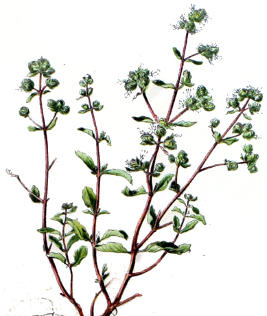 Origanum
majorana
Origanum
majoranaMarjoram
The Greek god Hymenaios (from whose name the words "hymn" and "hymen" come) presided over marriage celebrations in ancient Greece and wore a crown of marjoram, so consider this herb for spellwork to bring about marriage. Typically Hymenaios is depicted carrying a torch to light the bride's way to her bed (he's usually associated with the bride rather than the groom), but we have wondered if his torch might not align him with those deities who can travel to the Underworld, such as Hekate, especially because there is often a link in Greek magic between death and love (lots of love magic was done in cemeteries, for instance, or invoked Hekate as well as Aphrodite). Along those lines, marjoram was planted on graves in Malaysia. As an interesting echo of its use in ancient Greece, marjoram was an ingredient in English folk charms for divining whom one will marry. Some curanderos prescribe a tea made from sweet marjoram as a remedio for susto (shock), a sort of dislodging of the spirit that a person might suffer due to experiencing something traumatic, like a bereavement. The patient is woken at midnight to drink the tea. In the Middle Ages, marjoram was one of a number of herbs (including sage, rosemary, mace, cinnamon, basil, carnations, and the resins frankincense, myrrh, and mastic) that were smoldered as suffumigations to repel evil. Wild marjoram was used for bee magic in Ireland and as an ingredient in a paste (together with mastic and lotus) for exorcism in Hebrew magic. In medieval Europe, it was believed that wolves ate marjoram to sharpen their teeth and help their digestion.
Mundane Uses
Wild
marjoram is great for making fragrant wreaths and garlands. Native
to the Mediterranean. An ingredient in bouquet garni, fines herbes.
Also for sausage and pickling. Has a piney but also a spice aroma, and
so is both warm and cool. Many folks assign this herb to Mercury, which
then makes sense of the combination of opposites, since Mercury can do
that. Sweet marjoram has traditional uses for digestion, as a diuretic,
for causing beneficial sweating (to sweat out a cold, for instance), as
an antiseptic mouthwash or gargle, and for headaches. Some recommend
this herb for love charms, but it is actually an
anti-aphrodisiac. Usually it is drunk as a tea made from 1-2
teaspoons of the dried herb added to a cup of boiling water. Let step
for 15 minutes and drink one-half to one cup three times a day.
Marjoram is related to oregano, but marjoram is sweeter and less
intense.
How to Grow Wild Marjoram
Barely
cover
to germinate in 7-14 days at room temperature. Transplant out to full
sun spacing 12"/30cm apart. This plant gets 18-24"/45-60cm tall. This
perennial is
usually grown as an annual unless you live in South
Florida (zones 9-11). However, you can grow this in a
container and take it inside in winter. It takes 80-95 days to reach
maturity. Harvest when the flower buds are forming and dry by hanging,
then strip off the dried leaves. Don't forget to leave some flower for
the bees--they love them.
Origanum
majorana
Wild Marjoram
100 seeds $3.25
Uses in Witchcraft & Magic:
Love
Magic
Exorcism
Spiritual Healing
Mercury Herb
© 2010-2024 Alchemy Works; No reproduction without permission